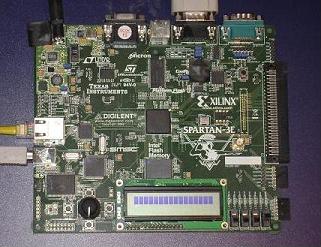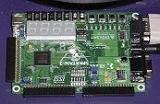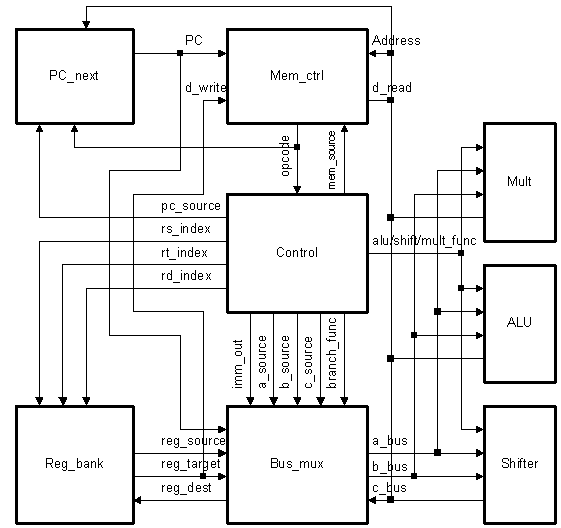 Plasma - most MIPS I(TM) opcodes
Plasma - most MIPS I(TM) opcodes
Project maintainers
Details
Created: Sep 25, 2001
Updated: Nov 21, 2016
SVN Updated: Aug 30, 2014
SVN: Browse
Latest version: download (might take a bit to start...)
Statistics: View
Bugs: 49 reported / 43 solved
Other project properties
Language:VHDL
Development status:Stable
Additional info:Design done, FPGA proven
WishBone compliant: No
WishBone version: n/a
License: Others
Description
The Plasma CPU is a small synthesizable 32-bit RISC microprocessor. It is currently running a live web server with an interrupt controller, UART, SRAM or DDR SDRAM controller, and Ethernet controller. The Plasma CPU executes all MIPS I(TM) user mode instructions except unaligned load and store operations (see "Avoiding Limitations" below).
This "clean room" CPU core is implemented in VHDL with either a two or three-stage pipeline. It is running at 25 MHz on a Xilinx FPGA and also verified on an Altera FPGA.
Success Stories
The Plasma CPU along with the Plasma RTOS and TCP/IP protocol stack are now running a live Web Server on a Xilinx FPGA.



Block diagram
IMAGE: cpu.gif
FILE: cpu.gif
DESCRIPTION:
Example Instruction
The CPU is implemented with a two or three stage pipeline with an additional optional stage for memory read and writes. (Using the three stage pipeline enables "pipeline.vhd" which delays some control signals into the next stage.)
An ADD instruction would take the following steps:
Stage #0:
-
1. The "pc_next" entity passes the program counter (PC) to the "mem_ctrl" entity which fetches the opcode from memory.
-
2. The memory returns the opcode.
-
3. "Mem_ctrl" passes the opcode to the "control" entity.
4. "Control" converts the 32-bit opcode to a 60-bit VLWI opcode and sends control signals to the other entities.
5. Based on the rs_index and rt_index control signals, "reg_bank" sends the 32-bit reg_source and reg_target to "bus_mux".
-
6. Based on the a_source and b_source control signals, "bus_mux" multiplexes reg_source onto a_bus and reg_target onto b_bus.
7. Based on the alu_func control signals, "alu" adds the values from a_bus and b_bus and places the result on c_bus.
8. Based on the c_source control signals, "bus_mux" multiplexes c_bus onto reg_dest.
9. Based on the rd_index control signal, "reg_bank" saves reg_dest into the correct register.
-
10. Read or write memory if needed.
Plasma Version 3 Features
The Plasma Version 3 core now contains a bidirectional serial port, interrupt controller, and hardware timer. Version 3.5 added a DDR SDRAM controller, Ethernet MAC, and Flash interface. There is C and assembly code for the Plasma Real-Time Operating System -- a fully preemptive RTOS supporting threads, semaphores, mutexes, message queues, timers, heaps, an interrupt manager, ANSI C library, single precision floating point library, TCP/IP protocol stack, and Web server.
List of Files
| FILE | PURPOSE (Directory: vhdl) |
| code.txt | Input opcodes for the test bench -- test.axf "converted" |
| mlite_pack.vhd | Constants and Functions Package |
| tbench.vhd | Test Bench that uses plasma.vhd |
| plasma_if.vhd | Top level interface to Xilinx or Altera FPGA |
| plasma_3e.vhd | Top level interface to Xilinx Spartan-3E with DDR |
| -ddr_ctrl.vhd | DDR controller |
| -plasma.vhd | CPU core with RAM and UART |
| --cache.vhd | Optional 4KB cache |
| --ram.vhd | Internal RAM for Altera FPGA |
| --ram_xilinx.vhd | Internal RAM for Xilinx FPGA |
| --uart.vhd | UART (can pause CPU if needed) |
| --eth_dma.vhd | Ethernet MAC with DMA |
| --mlite_cpu.vhd | Top Level VHDL for CPU core |
| ---alu.vhd | Arithmetic Logic Unit |
| ---bus_mux.vhd | BUS Multiplex Unit |
| ---control.vhd | Opcode Decoder |
| ---mem_ctrl.vhd | Memory Controller |
| ---mult.vhd | Multiplication and Division Unit |
| ---pc_next.vhd | Program Counter Unit |
| ---reg_bank.vhd | Register Bank for 32, 32-bit Registers |
| ---shifter.vhd | Shifter Unit |
| FILE | PURPOSE (Directory: tools) |
| makefile | Makefile for the PC for creating "code.txt" |
| plasma.h | Plasma header file for register addresses |
| boot.asm | Initializes $gp and $sp, clears .bss |
| opcodes.asm | Tests all the MIPS I(tm) opcodes |
| convert.c | Converts test.axf to code.txt |
| ram_image.c | Creates Xilinx RAM file ram_image.vhd from ram_xilinx.vhd and code.txt |
| bootldr.c | Serial port boot loader that can download another program |
| etermip.c | Terminal program to download code and transfer Ethernet packets | mlite.c | Simulates the CPU in software |
| bintohex.c | Converts test.exe to code[0-3].hex for lpm_ram for Altera FPGA |
| test.c | Test program (opcodes) for the CPU core |
| pi.c | Calculates the first 16 digits of PI |
| count.c | Test program that counts using words |
| ddr_init.c | Initialize the DDR chip |
| cpu.gif | Block Diagram |
| FILE | PURPOSE (Directory: kernel) |
| makefile | Makefile for Plasma RTOS |
| rtos.h | Header file for Plasma RTOS |
| rtos.c | Plasma pre-emptive Real-Time Operating System |
| libc.c | ANSI C library subset |
| math.c | Single precision floating point library |
| uart.c | Serial port driver |
| rtos_test.c | Test the RTOS functions |
| tcpip.h | TCP/IP header file |
| tcpip.c | TCP/IP protocol stack |
| ethernet.c | Ethernet MAC |
| http.c | Web server |
| filesys.c | File system |
| flash.c | Flash access |
| netutil.c | FTP server/client and telnet server |
Downloads
The Opencores Subversion web page can create the 130KB plasma_latest.tar.gz file containing all the latest code.
Tools
The MIPS(tm) GCC ELF compiler for Windows is available gccmips_elf.zip (2.4MB). The OpenCores server wouldn't let me save zip files so I had to rename it with an '.odt' extention. Rename the file from gccmips_elf.odt to gccmips_elf.zip before unzipping the files into the trunk\gccmips_elf directory. Add this directory to your executable PATH environment: set path=%PATH%;YOUR_DIR\trunk\gccmips_elf
If you use Windows and don't have a Microsoft C compiler for Windows, you will need pre-compiled versions of the tools (rename as tools.zip) which should be placed in the tools directory.
You may also need a Windows version of gmake. Rename the file gmake_zip.odt to gmake.zip before unzipping.
Supporting Documentation
See the tabs at the top for additional build instructions:
- The Plasma CPU instruction set
- Building the tools
- Additional Linux GNU MIPS tools
- Building the Plasma RTOS
- Building the Plasma TCP/IP stack
- "MIPS RISC Architecture" by Gerry Kane and Joe Heinrich
- "The Designer's Guide to VHDL" by Peter J. Ashenden
- Go to the MIPS Technologies, Inc. Web site http://www.mips.com/.
- Under the Products menu, click on Resource Library.
- Click on Product Materials in the submenu on the left.
- Click on MIPS Architecture from the next menu on the left.
- Finally, click on the link for "MIPS32® Architecture for Programmers Volume II: The MIPS32® Instruction Set (.pdf)".
Big/Little Endian
The CPU core operates in Big Endian mode by default. To operate in Little Endian mode, change "little_endian" from "00" to "11" in the file mem_ctrl.vhd.
Bus Interface
All signals are active high. Here are the signals for writing a character to address 0xffff when using a two stage pipeline:
entity mlite_cpu is
port(clk : in std_logic;
reset_in : in std_logic;
intr_in : in std_logic;
address_next : out std_logic_vector(31 downto 2); --for synch ram
byte_we_next : out std_logic_vector(3 downto 0);
address : out std_logic_vector(31 downto 2);
byte_we : out std_logic_vector(3 downto 0);
data_w : out std_logic_vector(31 downto 0);
data_r : in std_logic_vector(31 downto 0);
mem_pause : in std_logic);
end; --entity mlite_cpu
Program:
addr value opcode
=============================
3c: 00000000 nop
40: 34040041 li $a0,0x41
44: 3405ffff li $a1,0xffff
48: a0a40000 sb $a0,0($a1)
4c: 00000000 nop
50: 00000000 nop
intr_in mem_pause
reset_in byte_we Stages
ns address data_w data_r 40 44 48 4c 50
3600 0 0 00000040 00000000 34040041 0 0 1
3700 0 0 00000044 00000000 3405FFFF 0 0 2 1
3800 0 0 00000048 00000000 A0A40000 0 0 2 1
3900 0 0 0000004C 41414141 00000000 0 0 2 1
4000 0 0 0000FFFC 41414141 XXXXXX41 1 0 3 2
4100 0 0 00000050 00000000 00000000 0 0 1
Synthesis
The CPU core was synthesized for several different FPGAs:
- Xilinx Spartan-3E Starter Kit Board with a XC3S500 used 2021 of 4656 slices (43 percent). Image includes DDR and Ethernet controllers.
- Removing the multiplication unit reduces the size by 558 slices.
- Xilinx Spartan-3 Starter Kit Board with an Xilinx XC3S200 Spartan-3 FPGA.
- Altera EP20K200EFC484-2X FPGA.
Status
- All MIPS I(TM) instructions are implemented and tested (except the unsupported previously patented unaligned load and store opcodes).
- Currently running on an Altera EP20K200EFC484-2X FPGA and a Xilinx XC3S500 and XC3S200 FPGA.
- Also running on a Xilinx Spartan-3E starter kit with DDR SDRAM, Ethernet MAC, and Flash Controller.
- Running at 50 MHz on newer Xilinx FPGAs with three stage pipeline.
- See "opcodes.asm" for regression test.
- Supports Interrupts.
- Includes several C test programs: Calculating PI; Prime Numbers; Showing Numbers Using Words; the Plasma RTOS; and single precision floating point library.
Disclaimer
MIPS(R) is a registered trademark and MIPS I(TM) is a trademark of MIPS Technologies, Inc. in the United States and other countries. MIPS Technologies, Inc. does not endorse and is not associated with this project. OpenCores and Steve Rhoads are not affiliated in any way with MIPS Technologies, Inc.
Legal Notice
The Plasma CPU project has been placed into the public domain by its original author and is free for commercial and non-commercial use.
This software is provided "as is" and any express or implied warranties, including, but not limited to, the implied warranties of merchantability and fitness for a particular purpose are disclaimed.
Avoiding Limitations
This section describes how to avoid the two main limitations of the Plasma CPU core. The first limitation is that unaligned load and store operations are not supported since they were patented. This means that when loading or storing 32-bit values the memory address must be on a 32-bit aligned address. [The patent for the unaligned memory access instructions expired Dec 23, 2006.]
Most RISC CPUs have limited support for unaligned memory accesses. The GCC MIPS compiler does not normally generate unaligned memory accesses. Try compiling a C program and then look in the listing file if any of these MIPS instructions are used: LWL, LWR, SWL, or SWR. If needed, there is a GCC patch to never generate unaligned memory accesses at ultra-embedded->GCC Modifications.
The second main limitation of the Plasma CPU is that exceptions (BREAK and SYSCALL opcodes) must not be placed immediately after a branch instruction (in the branch delay slot). The main uses for exceptions are software interrupts for debugger support and calling operating system calls.
Plasma CPU Web Articles
Several groups have published how they have used the Plasma CPU.
- Book: System-level Test and Validation of Hardware/software Systems
- IEEE: Low-Cost Software-Based Self-Testing of RISC Processor Cores
- IEEE: A Cryptographic Coarse Grain Reconfigurable Architecture Robust Against DPA
- IEEE: Application and Analysis of RT-Level Software-Based Self-Testing for Embedded Processor Cores
- IEEE: Software-Based Self-Testing of Embedded Processors
- IEEE: Effective Software-Based Self-Test Strategies for On-Line Periodic Testing of Embedded Processors
- IEEE: Floating Point Hardware for Embedded Processors in FPGAs
- Research: Making visible the thermal behaviour of embedded microprocessors on FPGAs: a progress report
- Achieving Composability in NoC-Based MPSoCs Through QoS Management at Software Level
- Predictive Dynamic Frequency Scaling for Multi-Processor Systems-on-Chip
- Providing Better Multi-Processor Systems-on-Chip Resources Utilization by Means of Using a Control-Loop Feedback Mechanism
- A Self-adaptive communication protocol allowing fine tuning between flexibility and performance in Homogeneous MPSoC systems
- Evaluating the Impact of Task Migration in Multi-Processor Systems-on-Chip
- Exploration of task migration techniques for distributed memory MultiProcessor Systems on Chips
- Thesis: Efficient Verification of Bit-Level Pipelined Machines Using Refinement
- Thesis: Characterizing the Activity Factor in NBTI Aging Models for Embedded Cores
- Spanish: Design, Evaluation and Implementation of a Multicore Processor
- Portuguese: Harvard Architecture?
- Portuguese: Report of the Draft Amendment of the Organization of Interface
- Usage: Plasma soft processor on the Spartan board
- Verilog: Veritak VHDL to Verilog Translator
- Verilog: YF32 - A simple 32-bit CPU SOC Platform [original Chinese]

